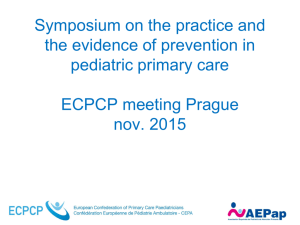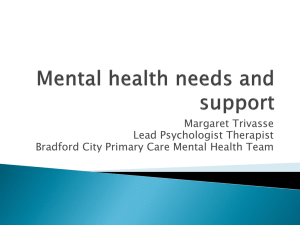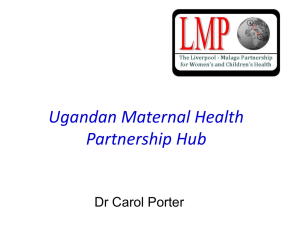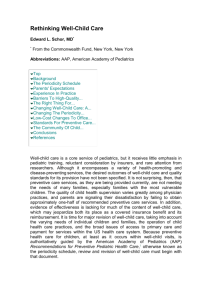communities of practice presentation heatlh
advertisement
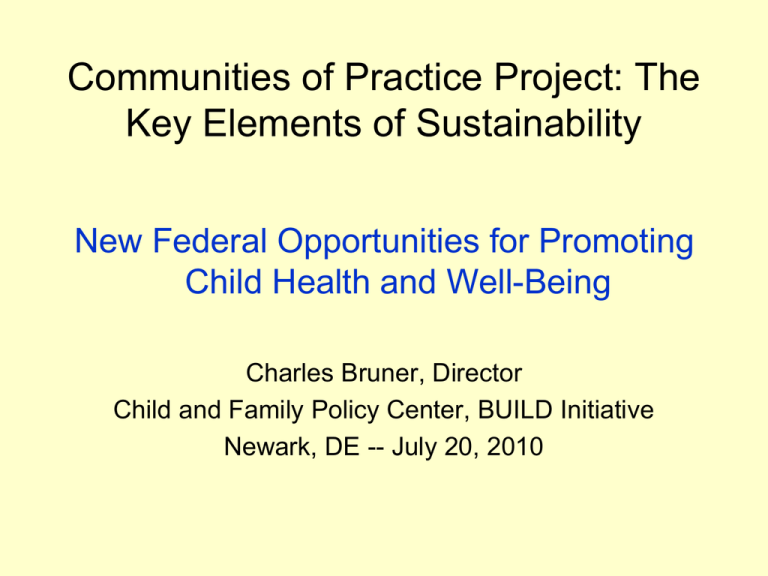
Communities of Practice Project: The Key Elements of Sustainability New Federal Opportunities for Promoting Child Health and Well-Being Charles Bruner, Director Child and Family Policy Center, BUILD Initiative Newark, DE -- July 20, 2010 New Federal Opportunities: A Narrative for Action 1. Healthy child development is multidimensional. 2. Health practitioners are the “first contact” with young children. 3. Exemplary strategies exist that address the multidimensionality of child health. 4. Federal health provisions offer the opportunity to address children’s healthy development. 5. States and communities must be intentional and creative to take advantage of these federal provisions. 6. Those who know best are in this room (but cannot do it alone). 1. Healthy Child Development is Multidimensional. Child health is … the extent to which individual children or groups of children are able or enabled to (a) develop and realize their potential, (b) satisfy their needs, and (c) develop the capacities that allow them to interact successfully with their biological, physical, and social environments. -- National Research Council and the Institute of Medicine. 2004. Children’s Health, the Nation’s Wealth: Assessing and Improving Child Health. social determinants of health life course model of healthy child development health equity 2. Health Practitioners are the “First Contact” with Young Children. % of All Children Involved in Following Services 88.5% 40.2% 28.6% 24.3% 3.8% Preventive Health Care Visit (0-5) EPSDT Visit (0-2) WIC Participation (0-5) Formal Child Care Arrangement (0-4) Head Start/Early Head Start (0-5) 5.8% 2.3% Part B of IDEA Part C of IDEA (3-5) (0-2) 3. Exemplary Strategies Address the Multidimensionality of Child Health ... ABCD Assuring Better Child Health & Development Connecticut’s Help Me Grow program … in the Following Ways. Pediatric Practitioner Training/Developmental Surveillance Care Coordination • ecological assessment and response •from referral to scheduling and follow-up • developmental screening • recognizing and responding to social determinants Community Connections • professional service responses • social connections and community support Child Mental Health Part C Peer Support Group for Grandparents Parentin g Education Church Family Night Program Home Visiting Parent of Children with ADHD Group Domesti c Violence Shelter Head Start Hispanic Resource Center Parents Anonymous 4. Federal Health Provisions Offer the Opportunity to Address Children’s Healthy Development. • CHIPRA Provisions – Expanded funding and options to states – Child health quality outcomes development and demonstration grants • PPACA Provisions – Coverage for preventive care and well-child care based upon recognized HRSA standards (Bright Futures) – Maternal, infant, and early childhood home visitation program – CMS healthcare innovation zones – Prevention and public health fund – Community transformation grants – Community health teams to support patient-centered medical homes & primary care extension program – Spending for community health centers + CCAC in Head Start Reauthorization, Promise Neighborhoods, etc. 5. States and Communities Must Be Intentional and Creative to Take Advantage of Federal Provisions. • Includes but is more than health IT, quality outcomes, and medical records • Includes but is more than reimbursement and screening tools • Includes but is more than clinical/medical care • Is more than but includes children in achieving health cost, quality, and accountable care goals 6. Those Who Know Best Are in This Room (But Cannot Do It Alone). • Identification of own needs and opportunities in the context of federal activities • Access to detailed information about opportunities • Partnerships with state and community advocates • Compelling messages to key stakeholders and decision-makers Additional Resources from CFPC • Healthy Child Storybook • Journal of Pediatrics Commentary • Children’s Healthy Development Model Act Contact Information Child & Family Policy Center and the The BUILD Initiative 505 5th Avenue, Suite 404 Des Moines, IA 50309 515-280-9027 www.cfpciowa.org www.buildinitiative.org www.finebynine.org Voices for America’s Children 1000 Vermont Street, NW Suite 700 Washington, DC 20005 202-289-0777 www.voices.org Additional Slides Outlining Outcomes, Exemplary Programs, and Strategies Source: Healthy Child Storybook Outcomes of Well-Child Care During the First Five Years of Life Domain of Well-Child Care Outcome at School Entry Child Physical Health and Development • • • • • • • • • • Child Emotional, Social, and Cognitive Development • All developmental delays recognized and treated (emotional, social, cognitive, communication) • Child has good self-esteem • Child recognizes relationship between letters and sounds • Child has adaptive skills and positive social behaviors with peers and adults Family Capacity and Functioning • Parents knowledgeable about child’s physical health status and needs • Warning signs of child abuse and neglect detected • Parents feel valued and supported as their child’s primary caregiver and function in partnership with the child health care provider • Maternal depression, family violence, and family substance abuse detected and referral initiated • Parents understand and area able to fully use well-child care services • Parents read regularly to the child • Parents knowledgeable and skilled to anticipate and meet a child’s developmental needs • Parents have access to consistent sources of emotional support • Parents linked to all appropriate community services All vision problems detected and corrected optimally All hearing problems detected and managed Management plans in place for all chronic health problems Immunization complete for age All congenital anomalies/birth defects detected All lead poisoning detected All children free from exposure to tobacco smoke Good nutritional habits and no obesity; attained appropriate growth and good health All dental caries treated Live and travel in physically safe environments Note: regular font bullets are those outcomes for which child health care providers should be held accountable for achieving. Italicized bullets are those outcomes to which child health care providers should contribute by educating parents, identifying potential strengths and problems and making appropriate referrals, but for which they are not independently responsible. Bright Futures Bright Futures approach: Health supervision that promotes physical, emotional, intellectual, and social health through a developmental perspective involving health supervision guidelines, training, and support for practitioners, families, and public health personnel. Bright Futures impacts: Research of state efforts to incorporate Bright Futures into practice have shown: Success in strengthening pediatric practice in using health supervision guidelines when champions are enlisted and training and resources provided to support that incorporation into practice Improvements in identification, response, and family involvement in addressing child health and development concerns identified through health supervision Improved coordination across health, education, and human services in meeting “whole child” concerns Help Me Grow Help Me Grow approach: Practitioner training to conduct whole child “developmental surveillance” during child health visits, with care coordinators following up with families to identify professional and community resources to address child needs and schedule appointments and visits, and community health liaisons identifying and working with community resources. Help Me Grow impacts: Research has shown that Help Me Grow dramatically increases identification of behavioral and developmental concerns within the practitioner’s office and leads to timely follow-up services, which include: Increased identification of developmental delays, parental depression and stress, and other child developmental concerns Increased use of Part C (early intervention) services Improvement in child health and development reported in followup pediatric visits Reach Out and Read Reach Out and Read approach: Training to doctors and nurses to make literacy promotion a standard part of pediatric care (encouraging parents to read to children as part of well-child visits) and proving the tools (a book at each visit) to do so Reach Out and Read Impacts: Research has found that Reach Out and Read: Increases parental reading to children in the home Improves children’s ability to express themselves verbally Increases children’s listening vocabularies Improves children’s preschool language scores Reduces the proportion of children with language delays that can prevent them from succeeding in school Assuring Better Child Health and Development (ABCD) Assuring Better Child Health and Development (ABCD) approach: Collaborations across Medicaid, pediatric providers, Maternal and Child Health, and Part C in developing strategies within Medicaid to improve developmental screening of young children and actions to improve healthy mental development. Assuring Better Child Health and Development (ABCD) impacts: Different states produced different gains in the identification and treatment of developmental issues for young children, including: Increased identification of developmental delays and more timely follow-up services under Part C of IDEA Earlier detection of autism and reduced time between identification and initiation of services Identification of signs of maternal depression and follow-up services to address this risk factor for healthy child development Increased provision of anticipatory guidance to parents on child development and greater response to parental concerns raised during well-child visits Healthy Steps for Young Children Healthy Steps approach: Incorporating within pediatric and family practice a Healthy Steps Specialist who provides additional links to the family in promoting healthy and developmentally appropriate practices in the home and ensuring early identification and treatment of medical issues Healthy Steps impacts: Research has found that Healthy Steps: Increases parental use of positive health practices, such as ensuring infants sleep on their backs, receive all vaccinations, and have injury prevention tools in their homes Improves interactions of parents with their toddlers, using more positive and less harsh disciplinary practices and paying more attention to their child’s behavioral clues Reduces toddler television viewing and improves child expressive vocabulary CenteringPregnancy CenteringPregnancy approach: The goal of Centering groups is to improve the overall health outcomes of mothers, babies, and new families by adopting a group health model of care that emphasizes care, honors the contribution of each member, and uses a facilitative leadership style. CenteringPregnancy impacts: Both participants and providers report satisfaction with the Centering model. Research has shown a series of improved outcomes for women and babies, including: reductions in emergency department visits by the third trimester reductions in low birth-weight births among preterm deliveries reductions in preterm births Community Care of North Carolina/ Carolina ACCESS CCNC/CA approach: Implementing a medical home model for Medicaid and CHIP recipients, and providing care coordination to ensure continuity and ease of medical care. The goal of the program is to better address both medical and social determinants of child health. CCNC/CA impacts: Research from the University of North Carolina’s Sheps Center for Health Services Research of the asthma and diabetes management initiatives has shown: • improvement in child health outcomes, and • significant cost savings from the program. Research from the Mercer Human Resources Consulting group has shown: • increased use of primary and preventive services, and • substantial savings to Medicaid in terms of reduced emergency room use and hospitalizations. Opportunities for Prevention, Early Identification and Treatment During Pediatric Visits Issue or Concern Healthy Development Impact Nutrition and exercise Obesity and diabetes Exposure to second-hand smoke SIDS, respiratory illness, asthma, cognitive development, adult cancer, heart problems Maternal depression Social/emotional development, school success, safety Oral health Propensity for illness, pain, and school success Vision Reading and school success Autism Early treatment leading to more success and less disruption American Academy of Pediatrics Recommended Health Supervision Practices Regarding the Prevention of Obesity • • • • Identify and track patients at risk by virtue of family history, birth weight, or socioeconomic, ethnic, cultural, or environmental factors. Calculate and plot BMI (body mass index) once a year and use change in BMI to identify rate of excessive weight gain relative to linear growth. Encourage, support, and protect breast feeding. Encourage parents and caregivers to promote healthy eating patterns by offering nutritious snacks such as vegetables and fruits, low-fat dairy foods, and whole grains. • Encourage children’s autonomy in self-regulation of food intake and setting appropriate limits on choices; and modeling healthy food choices. • Routinely promote physical activity, including unstructured play at home, in school, in child care settings, and throughout the community. • Recommend limitation of television and video time to a maximum of two hours per day. Limiting Child Exposure to Second-Hand Smoke: Recommended Actions • Routine queries about parental smoking and exposure to second-hand smoke as part of wellchild visits • Follow-up recommendations (anticipatory guidance) regarding eliminating second-hand smoke, through: – Quitting – Using nicotine replacement therapies – Smoking only outside the home and automobile and when not in the presence of children Maternal Depression and Children’s Healthy Development Recent findings on maternal depression and children’s healthy development: • Screening for maternal depression can be done efficiently and effectively during well-child visits and there is a good uptake by mothers on further assessments and treatment, where those are available. • Addressing and alleviating maternal depression produces positive results for children, including: improved social interactions, approaches to learning, social and emotional physical health. Vision Screening • Half of low-income children have vision problems that interfere with school success. • Early vision screening and basic exercise therapies can address vision problems and lead to improved literacy and educational success as well as general healthy development.
